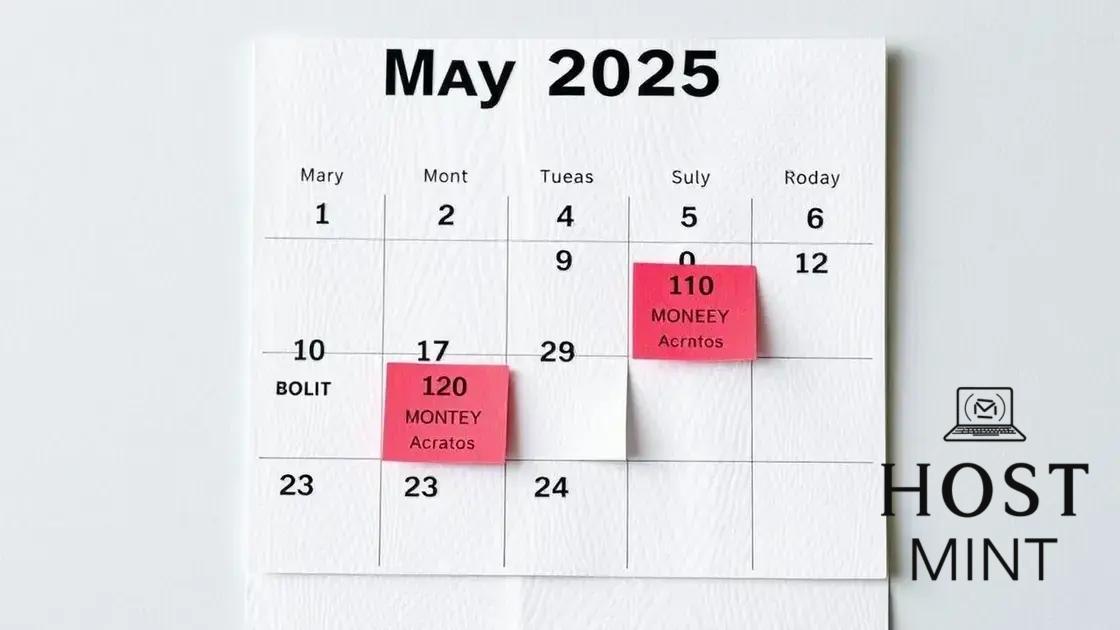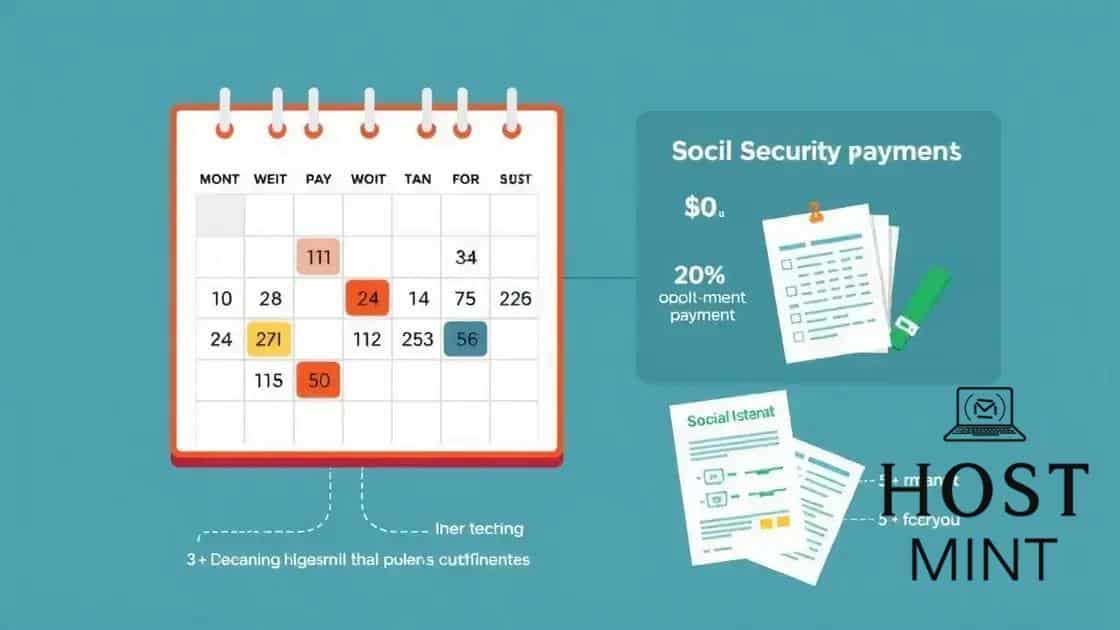Social Security payment schedule for May 2025 explained

The Social Security payment schedule for May 2025 includes payments on the second, third, and fourth Wednesdays, depending on your birth date, allowing for effective financial planning.
The Social Security payment schedule for May 2025 is crucial for those relying on these benefits. With several important dates to consider, ensuring you get the most out of your payments can make a significant difference in financial planning. Let’s dive into what you need to know.
Understanding Social Security payments
Understanding Social Security payments is vital for anyone anticipating these benefits. As we explore how these payments work, it’s essential to grasp various aspects that can affect the amount you receive.
How Social Security Works
Social Security provides monthly financial assistance to individuals who have retired or are unable to work due to a disability. These payments are funded through payroll taxes, which are collected from workers and their employers.
Eligibility for Payments
To qualify for Social Security payments, you must have earned a certain number of credits. Generally, you gain one credit for every year you work, up to four credits per year.
- Eligibility begins at age 62 for retirees.
- Disabled workers may receive benefits earlier.
- Death benefits are available for dependent family members.
It’s crucial to keep track of your earnings record, which is maintained by the Social Security Administration. This record confirms your eligibility and helps determine your payment amount.
Factors Affecting Payment Amounts
The amount you receive from Social Security can vary based on several factors. Primarily, your average indexed monthly earnings determine the benefit level. Factors such as the age at which you start receiving benefits also play a role.
The longer you wait to claim benefits, the higher the amount you can receive each month. Conversely, if you start receiving payments early, you may face permanent reductions.
Understanding these elements will help you make informed decisions about the best time to claim benefits and plan your financial future effectively.
Key dates in May 2025

Understanding the key dates in May 2025 for Social Security payments is essential for effective financial planning. These dates determine when beneficiaries can expect their payments, ensuring that individuals can budget their expenses accordingly.
Payment Schedule Overview
The Social Security Administration provides a set payment schedule each month. In May 2025, payments will be distributed based on the birth date of the beneficiaries. Knowing this schedule can help avoid any confusion or missed payments.
- If your birthday falls between the 1st and 10th of the month, you’ll receive your payment on the second Wednesday of May.
- Those born between the 11th and the 20th will see their payments on the third Wednesday.
- Finally, beneficiaries with birthdays from the 21st onward receive their payments on the fourth Wednesday.
Tracking these dates can greatly improve your financial management and help you plan your month better.
Other Important Dates
Besides the actual payment dates, several other important dates may affect your benefits. For instance, if you have pending applications or changes in your benefit amounts, being aware of deadlines and scheduled events is crucial. You must also stay informed about any related legislation that may impact Social Security. Updates are often shared through official channels, and keeping an eye on these announcements can be beneficial.
Understanding the key dates in May 2025 is just one part of managing your Social Security benefits effectively. Staying organized will help you avoid any surprises and allow you to focus on other matters that require your attention.
How payment amounts are determined
Understanding how payment amounts are determined is crucial for anyone expecting Social Security benefits. These amounts vary based on several factors, making it essential to grasp the criteria that influence your payment.
Calculation of Benefits
The Social Security Administration calculates your benefits using your earnings during your working years. They look at your highest-earning 35 years to determine your average indexed monthly earnings (AIME). This method means that higher lifetime earnings result in higher benefits.
Impact of Full Retirement Age
Your full retirement age (FRA) is also a determining factor. If you start collecting benefits before hitting your FRA, your monthly payment may be permanently reduced. Conversely, if you delay receiving your benefits past your FRA, your monthly payment will increase.
- Claiming at age 62 lowers payments significantly.
- Delaying benefits until age 70 can increase monthly payments by up to 32%.
- Understand how your FRA affects total benefits.
It’s also important to note that your payment amount can be affected by cost-of-living adjustments (COLA), which are made to ensure benefits keep pace with inflation. These adjustments help your benefits maintain their purchasing power over time.
Other Considerations
Other factors may impact your final payment amount, such as work after retirement. If you continue to work while receiving Social Security, your earnings could reduce your benefits if you haven’t reached your FRA. Understanding these nuances can help you make informed choices about when to start receiving benefits.
By knowing how your payment amounts are calculated, you can better prepare for your financial future and enjoy peace of mind regarding your Social Security benefits.
Factors affecting your payment schedule

When it comes to understanding the factors affecting your payment schedule, several key elements come into play. These factors can influence when and how much you receive from Social Security.
Birth Date
Your birth date significantly impacts your payment schedule. Social Security payments are distributed based on the day of the month you were born. This system divides recipients into categories, affecting when each group receives its payment.
- Those born from the 1st to 10th get payments on the second Wednesday of the month.
- Individuals with birthdays from the 11th to the 20th receive payments on the third Wednesday.
- For those born from the 21st to 31st, payments are issued on the fourth Wednesday.
Being aware of these dates helps you plan your finances more effectively.
Income Level
Your income level can also influence your eligibility for benefits, especially if you are still working after retiring. If you exceed specific income thresholds before reaching your full retirement age, it may reduce your monthly payment amounts.
Understanding income limits is essential, as this affects not only how much you receive but also when you receive it. The Social Security Administration assesses your earnings and adjusts your payment accordingly.
Changes in Benefits
Adjustments in your benefits can occur for several reasons. If you or your spouse are receiving benefits and experience a change in circumstances, such as remarriage or entering a nursing home, it could affect your payment schedule.
Additionally, any changes to cost-of-living adjustments (COLA) or updates to Social Security laws may also impact your payment dates. Staying informed about these changes is crucial for keeping your financial planning on track.
Tips for managing your benefits
Managing your Social Security benefits effectively can help you make the most of your retirement or disability payments. Here are some practical tips to help you stay organized and maximize your benefits.
Keep Track of Your Payment Schedule
Understanding when to expect your payments is essential for budgeting. Regularly check the payment schedule for each month, especially if there are holidays or changes in your benefit dates. Being proactive can help you avoid any financial surprises.
Review Your Earnings Record
It’s wise to request and review your earnings record at least once a year. This record shows your work history and the earnings used to calculate your benefits. If you spot any mistakes, you can correct them early. This helps ensure that your future payments accurately reflect your contributions.
- Request a copy of your earnings record from the Social Security Administration.
- Check for any inconsistencies or missing income.
- Correct errors as soon as possible to avoid affecting your future payments.
Being aware of your earnings can help you know what to expect in terms of benefits.
Plan for Changes
Life changes, like marriage, divorce, or a new job, can affect your benefits. Keeping the Social Security Administration informed about changes in your situation is crucial. This ensures that your benefits are adjusted accordingly. Additionally, understand how these changes can impact your payment amounts or eligibility.
Utilizing financial planning tools, like budgeting apps, can also assist in managing your monthly expenses. This way, you can better plan how your Social Security payments fit into your overall financial picture.
By following these tips for managing your benefits, you can feel more confident about your financial future and make informed decisions that align with your needs.
FAQ – Frequently Asked Questions about Social Security Benefits
When will I receive my Social Security payment?
Your payment date depends on your birth date. Payments are scheduled based on the day of the month you were born.
How is my Social Security payment amount determined?
Your payment amount is based on your earnings over your working years, specifically the highest 35 years of income.
Can my benefits change over time?
Yes, your benefits can be adjusted based on cost-of-living increases or changes in your personal circumstances.
What should I do if my payment is late?
If your payment doesn’t arrive on time, contact the Social Security Administration immediately for assistance.






